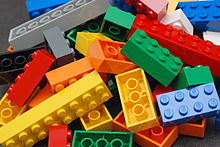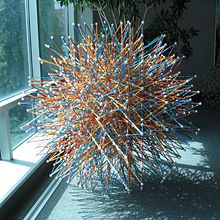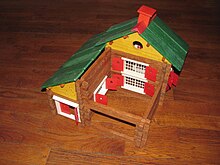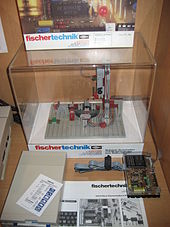Thành viên:Mine Fellucia/Mô hình lắp ghép


60 Fullerene.




A mô hình lắp ghép hay bộ đồ lắp ráp is a set of standardized pieces that allow for the construction of a variety of different models. Construction sets are generally marketed as toys. One very popular brand of construction set toys is Lego.
Toys
sửaPsychological benefits
sửaConstruction toy play is beneficial for building social skills and building trust in others because it acts as a collaborative task where individuals have to cooperate to finish the task – building an object out of Lego, for example. The effect was found in high school students.[1]
For children specifically, children who complete models using toy building blocks have much better spatial ability than children who do not complete such models. Spatial ability also predicts completion of models.[2]
Construction toy play is also beneficial for autistic children when both individual and group play with building blocks is incorporated. Autistic children who played with building blocks were motivated to initiate social contact with children their age, able to maintain and endure contact with those children, and were also able to surpass the barriers of being withdrawn and highly-structured.[3]
Categories
sửaConstruction sets can be categorized according to their connection method and geometry:
- Struts of variable length that are connected to any point along another strut, and at nodes.
- Tesseract connection points are initially flexible but can be made rigid with the addition of clips.
- Struts of fixed but multiple lengths that are connected by nodes are good for building space frames, and often have components that allow full rotational freedom.
- D8h (*228) nodes are used for K'Nex, Tinkertoys, Playskool Pipeworks, Cleversticks and interlocking disks in general.
- D6h nodes are used for interlocking disks.[4]
- Ih (*532) nodes are used for Zometool
- Panels of varying sizes and shapes
- Panels of varying sizes and shapes are connected by pins or screws perpendicular to the panels, which are good for building linkages such as an Erector Set, Mini Unit Beams, Meccano, Merkur, Steel Tec, Lego Technic, Trix, FAC-System, Constructo Straws, and Überstix
- Panels of varying sizes and shapes with flexible panels or hinges between panels such as Tog'l, Jovo Click 'N Construct, Zaks, and Polydron.
- Struts and panels
- Girder and Panel building sets
- Synestructics (does not make pentagonal structures)
- Ramagon (some panels include studs for connecting with Lego clones)
- Geomag (components are magnetic)
- Bayko
- Building components with various methods of connection include:
- No connection: toy blocks, Anchor Stone Blocks, KEVA planks, Kapla, and Unit Bricks
- Studs: Engino, Rokenbok, Lego, Lego clones, Coco, Rasti, Tente, Mega Bloks, Fischertechnik, Playmobil, Loc Blocs, Cobi blocks, Betta Builda, Guangdong Loongon (and its subbrands: Cogo, Lepin, Xingboa) and Oxford, Kre-O, Clementoni mechanics.
- Notches: Lincoln Logs, GIK, and Stickle bricks
- Sleeves: Capsela
- Spherical magnets
- Many marble run toys are construction sets.
Influence on architecture
sửaRenowned architect Frank Lloyd Wright credited his childhood building blocks designed by Friedrich Fröbel as a major influence, and his son John Lloyd Wright invented the widely-known Lincoln Logs building set.[5] In addition to teaching architectural concepts such as modularity and load-bearing construction,[6] many architects credit construction set play as influencing their later design.[5]
See also
sửa- Pontiki, construction toy for building models of unusual creatures
- Unit block
References
sửa- ^ Kato, D.; Hattori, K.; Iwai, S.; Morita, M. (2012). “Effects of collaborative expression using LEGO® blocks, on social skills and trust”. Social Behavior and Personality. 40 (7): 1195–1200. doi:10.2224/sbp.2012.40.7.1195.
- ^ Brosnan, M. J. (1998). “Spatial ability in children's play with Lego blocks”. Perceptual and Motor Skills. 87 (1): 19–28. doi:10.2466/pms.1998.87.1.19. PMID 9760621. S2CID 22808504.
- ^ LeGoff, D. B. (2004). “Use of LEGO© as a Therapeutic Medium for Improving Social Competence”. Journal of Autism and Developmental Disorders. 34 (5): 557–571. doi:10.1007/s10803-004-2550-0. PMID 15628609. S2CID 9889621.
- ^ Kondinski, A.; Moons, J.; Zhang,Y.; Bussé, J.; De Borggraeve, W.; Nies, E.; Parac-Vogt, T.N. (2019). “Modeling of Nanomolecular and Reticular Architectures with 6-fold Grooved, Programmable Interlocking Disks”. Journal of Chemical Education. 97: 289–294. doi:10.1021/acs.jchemed.9b00739. S2CID 208759028.
- ^ a b Heathcote, Edwin (9 tháng 8 năm 2013). “Toytown and the city”. Financial Times. The Financial Times Limited. Lưu trữ bản gốc ngày 15 tháng 8 năm 2013. Truy cập ngày 17 tháng 12 năm 2013.
- ^ Stewart, Matt (12 tháng 6 năm 2013). “Modern toys curb creativity – academics”. Stuff.co.nz. Fairfax New Zealand Limited. Lưu trữ bản gốc ngày 19 tháng 12 năm 2013. Truy cập ngày 17 tháng 12 năm 2013.